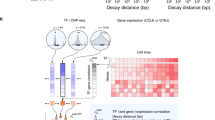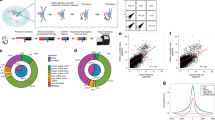Abstract
Molecular interactions between protein complexes and DNA mediate essential gene-regulatory functions. Uncovering such interactions by chromatin immunoprecipitation coupled with massively parallel sequencing (ChIP-Seq) has recently become the focus of intense interest. We here introduce quantitative enrichment of sequence tags (QuEST), a powerful statistical framework based on the kernel density estimation approach, which uses ChIP-Seq data to determine positions where protein complexes contact DNA. Using QuEST, we discovered several thousand binding sites for the human transcription factors SRF, GABP and NRSF at an average resolution of about 20 base pairs. MEME motif-discovery tool–based analyses of the QuEST-identified sequences revealed DNA binding by cofactors of SRF, providing evidence that cofactor binding specificity can be obtained from ChIP-Seq data. By combining QuEST analyses with Gene Ontology (GO) annotations and expression data, we illustrate how general functions of transcription factors can be inferred.
This is a preview of subscription content, access via your institution
Access options
Subscribe to this journal
Receive 12 print issues and online access
$259.00 per year
only $21.58 per issue
Buy this article
- Purchase on Springer Link
- Instant access to full article PDF
Prices may be subject to local taxes which are calculated during checkout




Similar content being viewed by others
References
Cawley, S. et al. Unbiased mapping of transcription factor binding sites along human chromosomes 21 and 22 points to widespread regulation of noncoding RNAs. Cell 116, 499–509 (2004).
Pokholok, D.K., Zeitlinger, J., Hannett, N.M., Reynolds, D.B. & Young, R.A. Activated signal transduction kinases frequently occupy target genes. Science 313, 533–536 (2006).
Birney, E. et al. Identification and analysis of functional elements in 1% of the human genome by the ENCODE pilot project. Nature 447, 799–816 (2007).
Lieb, J.D. Genome-wide mapping of protein-DNA interactions by chromatin immunoprecipitation and DNA microarray hybridization. Methods Mol. Biol. 224, 99–109 (2003).
Johnson, D.S., Mortazavi, A., Myers, R.M. & Wold, B. Genome-wide mapping of in vivo protein-DNA interactions. Science 316, 1497–1502 (2007).
Robertson, G. et al. Genome-wide profiles of STAT1 DNA association using chromatin immunoprecipitation and massively parallel sequencing. Nat. Methods 4, 651–657 (2007).
Mardis, E.R. ChIP-seq: welcome to the new frontier. Nat. Methods 4, 613–614 (2007).
Barski, A. et al. High-resolution profiling of histone methylations in the human genome. Cell 129, 823–837 (2007).
Wold, B. & Myers, R.M. Sequence census methods for functional genomics. Nat. Methods 5, 19–21 (2008).
Johnson, D.S. et al. Systematic evaluation of variability in ChIP-chip experiments using predefined DNA targets. Genome Res. 18, 393–403 (2008).
Parzen, E. On estimation of a probability density function and mode. Ann. Math. Stat. 33, 1065–1076 (1962).
Rosmarin, A.G., Resendes, K.K., Yang, Z., McMillan, J.N. & Fleming, S.L. GA-binding protein transcription factor: a review of GABP as an integrator of intracellular signaling and protein-protein interactions. Blood Cells Mol. Dis. 32, 143–154 (2004).
Lin, J.M. et al. Transcription factor binding and modified histones in human bidirectional promoters. Genome Res. 17, 818–827 (2007).
Cen, B., Selvaraj, A. & Prywes, R. Myocardin/MKL family of SRF coactivators: key regulators of immediate early and muscle specific gene expression. J. Cell. Biochem. 93, 74–82 (2004).
Posern, G. & Treisman, R. Actin' together: serum response factor, its cofactors and the link to signal transduction. Trends Cell Biol. 16, 588–596 (2006).
Pipes, G.C., Creemers, E.E. & Olson, E.N. The myocardin family of transcriptional coactivators: versatile regulators of cell growth, migration, and myogenesis. Genes Dev. 20, 1545–1556 (2006).
Cooper, S.J., Trinklein, N.D., Nguyen, L. & Myers, R.M. Serum response factor binding sites differ in three human cell types. Genome Res. 17, 136–144 (2007).
Collins, P.J., Kobayashi, Y., Nguyen, L., Trinklein, N.D. & Myers, R.M. The ets-related transcription factor GABP directs bidirectional transcription. PLoS Genet. 3, e208 (2007).
Schoenherr, C.J. & Anderson, D.J. Silencing is golden: negative regulation in the control of neuronal gene transcription. Curr. Opin. Neurobiol. 5, 566–571 (1995).
Ballas, N., Grunseich, C., Lu, D.D., Speh, J.C. & Mandel, G. REST and its corepressors mediate plasticity of neuronal gene chromatin throughout neurogenesis. Cell 121, 645–657 (2005).
Philippar, U. et al. The SRF target gene Fhl2 antagonizes RhoA/MAL-dependent activation of SRF. Mol. Cell 16, 867–880 (2004).
Bailey, T.L. & Elkan, C. Fitting a mixture model by expectation maximization to discover motifs in biopolymers. in Proceedings of the Second International Conference on Intelligent Systems for Molecular Biology 28–36 (AAAI Press, Menlo Park, California, 1994).
Schoenherr, C.J., Paquette, A.J. & Anderson, D.J. Identification of potential target genes for the neuron-restrictive silencer factor. Proc. Natl. Acad. Sci. USA 93, 9881–9886 (1996).
Madsen, C.S., Regan, C.P. & Owens, G.K. Interaction of CArG elements and a GC-rich repressor element in transcriptional regulation of the smooth muscle myosin heavy chain gene in vascular smooth muscle cells. J. Biol. Chem. 272, 29842–29851 (1997).
Buchwalter, G., Gross, C. & Wasylyk, B. Ets ternary complex transcription factors. Gene 324, 1–14 (2004).
Mortazavi, A., Leeper Thompson, E.C., Garcia, S.T., Myers, R.M. & Wold, B. Comparative genomics modeling of the NRSF/REST repressor network: from single conserved sites to genome-wide repertoire. Genome Res. 16, 1208–1221 (2006).
Crooks, G.E., Hon, G., Chandonia, J.M. & Brenner, S.E. WebLogo: a sequence logo generator. Genome Res. 14, 1188–1190 (2004).
Acknowledgements
This work was supported by US National Institutes of Health grants 5 U01 HG003162 and 1 U54-HG004576 to R.M.M., and by funds from the Stanford Pathology and Genetics Ultra-High Throughput Sequencing Initiative. We thank L. Tsavaler for performing the Illumina expression analysis, W.H. Wong, K. McCue and members of Sidow lab for valuable discussions and suggestions.
Author information
Authors and Affiliations
Contributions
A.V., S.B., An.S. and Ar.S. conceived the QuEST peak calling concept and developed the preliminary statistical framework. A.V. further developed and refined the statistical framework, and implemented QuEST. R.M.M. and D.S.J. devised the ChIP experiments. D.S.J., C.M. and E.A. performed the ChIP experiments. A.V. applied QuEST to the sequence data, and produced all quantitative results. A.V. and Ar.S. wrote the manuscript. A.V., D.S.J., S.B., R.M.M. and Ar.S. edited the manuscript.
Corresponding author
Supplementary information
Supplementary Text and Figures
Supplementary Figures 1–6, Supplementary Tables 1–3, Supplementary Methods (PDF 2728 kb)
Rights and permissions
About this article
Cite this article
Valouev, A., Johnson, D., Sundquist, A. et al. Genome-wide analysis of transcription factor binding sites based on ChIP-Seq data. Nat Methods 5, 829–834 (2008). https://doi.org/10.1038/nmeth.1246
Received:
Accepted:
Published:
Issue Date:
DOI: https://doi.org/10.1038/nmeth.1246
This article is cited by
-
Increased peak detection accuracy in over-dispersed ChIP-seq data with supervised segmentation models
BMC Bioinformatics (2021)
-
Control of a programmed cell death pathway in Pseudomonas aeruginosa by an antiterminator
Nature Communications (2021)
-
iProDNA-CapsNet: identifying protein-DNA binding residues using capsule neural networks
BMC Bioinformatics (2019)
-
MD-SVM: a novel SVM-based algorithm for the motif discovery of transcription factor binding sites
BMC Bioinformatics (2019)
-
Exploratory Gene Ontology Analysis with Interactive Visualization
Scientific Reports (2019)



